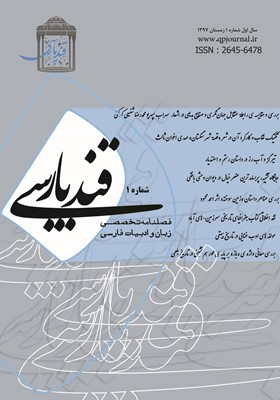تیر گز و آب رز در داستان رستم و اسفندیار
محورهای موضوعی : Critique of texts
1 - دانشگاه فرهنگیان
کلید واژه: فردوسی, شاهنامه, داستان رستم و اسفندیار, تیر گز, آب رز,
چکیده مقاله :
در داستان نبرد رستم و اسفندیار، دو ترکیب «تیر گز» و «آب رز»، پرسشها و پاسخهای بسیاری را پدید آورده است. محققان تقریباً از چند منظر به این داستان و عناصر آن نگریسته و تحلیلهایی ارائه نمودهاند. در این مقاله کوشیده شده تا با نقد آن نظرات، اولاً تأکید شود که تأویل ساختارگرایی از عناصر این داستان بر مبنای تقابل دینی یا سنت و تجدد، تفسیری پذیرفتنی است؛ ثانیاً برای این داستان و عناصر آن میتوان تحلیل نمادین هم ارائه داد و در آن صورت، این دو ترکیب، معانی نمادین گوناگونی را برمیتابند؛ ثالثاً تأویل واقعگرایی از این عناصر نیز با توجه به مستندات دو کتاب «عجایبالمخلوقات» و «زراتشتنامه» امکانپذیر است که در آن صورت، «تیر گز» و «آب رز» هر دو در معنای واقعی هستند و به دلیل قدمت و تقدس در تیر کشندة اسفندیار به کار رفتهاند.
In the story of the battle of Rostam and Isfandiar, to combinations of “Gaz arrow” and “wine” have raised questions and answers from many researchers. They have been focusing on this story and its elements from a number of viewpoints and presented various analyses. Reviewing these viewpoints, this paper tried to, firstly emphasis that structuralism interpretation of the elements of this story on the base of religious confrontation or tradition and modernity is an acceptable interpretation. Secondly, for this story and its elements a symbolic analysis can be represented and then these combinations can imply different symbolic meanings. Thirdly, the real interpretation of these elements is possible considering the documents of two books “Ajayebolmakhlooghat” [The wonders of creatures] and “Zaratooshtnameh” [book of Zaratoosht]. In that case, “Gaz arrow” and “wine” both are used in their real names having oldness and holiness used in the arrow which killed Isfandiar.
